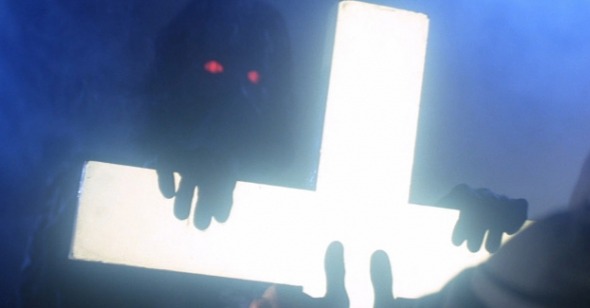First Night:
The Fog
I knew what I was getting into, but after putting myself through The Texas Chainsaw Massacre: The Beginning this weekend, I started to question and distrust my own taste for the macabre. Of course, this was only a momentary lapse spurred on by the soul-deadening experience of Jonathan Liebesman’s effectively gory yet ill paced, plotted, and conceived prequel to the Chainsaw series. This continuing tale needs an “origin” story like it needs a hole in the head (or abdomen as the case might be)…a psychoanalysis of Leatherface, blaming an abbatoired upbringing and mocking schoolmates? Uh, yeah. Leatherface only works as an image of the unthinkable, not as a full-fledged thinking individual; he thus loses his power as a conceit. However, more importantly, the film simply feeds into the recent trend of pure torture overtaking the suspense and playfulness the genre used to wield. Sure, Hostel at least tried for some sort of poltical commentary-cum-satire and the Saw films are memorably grotesque, but neither are as clever or well-crafted by half as the films their filmmakers all claim as influences (Tobe Hooper’s Chainsaw original, Halloween, etc.)
So, feeling depressed by the sheer lack of imagination (why have shock and depravity been completely substituted for ingenuity and ideas in the current glut of gorefests?) in current horror hits, I’d like to put forth a list of some great examples of the genre, just in time for Halloween. These films will run the gamut from solely atmospheric to deeply intestinally unpleasant, so a proper opener is someone who has always dabbled a bit in both, the singularly unsingular John Carpenter. Never overdecorative in his art direction, never overtly showy with his camera moves, Carpenter nevertheless quickly eked out a place for himself as one of the finest craftsmen in horror, using equal parts restraint and violence, emphasizing sound and image at once, in wholly unexpected and sense-heightening ways.
There may be no better place to start the Carpenter oeuvre than with his independently produced 1978 breakout Halloween, but for me, there’s really no finer example of Carpenter’s elegance than his much-anticipated follow-up, 1980’s The Fog. A more effective example than even Halloween of how setting and composition can make a scary movie, The Fog is one of just a handful of horror films I would call “beautiful.” Its first fifteen minutes, and much of it thereafter, are made up of gorgeously ominous shots of the natural environs of its location, the North Californian fishing village Antonio Bay, composed in elegant widescreen, and often accompanied by Carpenter’s own delicate piano chords. What’s most surprising about The Fog, and why it holds up so well 26 years after its release and one year after its severely loathed teeny-bopper remake, is that its central ghost-story hokum (about long-dead leper fishermen who have returned to the cursed Antonio Bay hundreds of years after the town’s elders murdered them and stole their gold, looking for revenge) works in perfect deference to the lovely imagery.
Most importantly, The Fog is utterly earnest in its telling—as exemplifed by John Houseman’s cameo prologue as a crusty seaside storyteller and the Edgar Allan Poe quote that precedes it, The Fog believes in the power of a good-old fashioned ghost story. The tale seems dog-eared and stale, yet there’s no ironic removal or self-referentality. True, the characters seem slightly secondary to the superb photography, but the host of late seventies/early eighties genre standbys (Adrienne Barbeau, Jamie Lee Curtis, Tom Atkins, Hal Holbrook, and Janet Leigh) play their parts with an infectious, likable enthusiasm that transcends any thinness in the characterizations.
No one would make claims for The Fog as a great artistic statement, but it has so many memorable creep-outs and such expertly paced scares, all done with such low-budget ingenuity, that it leaves you giddy—there’s more primal, shivery goodness in one handsomely composed shot here than most films can achieve in their entirety. Halloween may be more iconic and narratively satisfying, and The Thing (1982) does display some of the most dazzling, horrific sights crafted during the heyday of horror effects, but The Fog could stand as Carpenter’s true testament to the genre he so loves; along with Jacques Tourneur’s comparably silly yet superbly accomplished Cat People, it would make an effective study aid for future horror filmmakers on how to use editing and cinematography to heighten tension and create visual nuance. This is all the more impressive for its being a relatively negligible flick about angry ghost pirates. —Michael Koresky
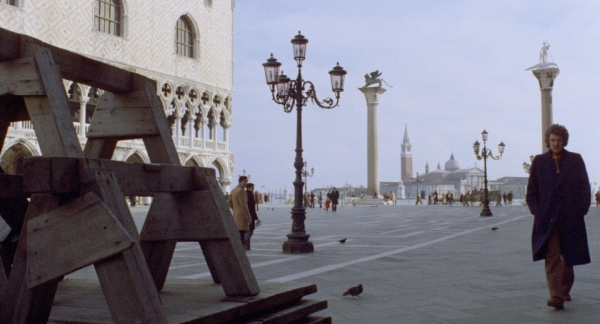
Second Night:
Don’t Look Now
Cross your fingers that a remake never happens. Every moment of Don’t Look Now is unthinkable in any other way, or with any of its shards moved even an inch out of place. Director Nicolas Roeg is sometimes accused of coldness, impersonality, and of jumping so quickly between tones and genres that he lacks a distinct imprint. But what Roeg and Donald Sutherland and Julie Christie were able to accomplish in Don’t Look Now still feels unmatched in the horror genre: the ultimate coupling of love and death, both represented in their extremes. Don’t Look Now may be famous for its creep-outs—and rightfully so: all that time it devotes to watching Sutherland’s mourning father wandering the decrepit nighttime streets of a Venice drained of tourists at the end of the season puts even Visconti’s Thomas Mann adaptation to shame. But why it sticks with us so many years later is that its horrors are so dependent on sadness. And it’s a real, true, gut-wrenching sadness, one which supernatural intervention can try to assuage, but for which it is ultimately meaningless.
The film's infamous sex scene isn’t renowned for its graphic nature so much as its delicate editing conceit: Sutherland and Christie’s John and Laura Baxter, in Venice both for his art restoration work and for their post-trauma necessity, make love, gently, while Roeg and editor Graeme Clifford intercut their quiet passion with postcoital dressing for dinner. The result is one of the most intimate scenes of marriage ever put on film (Soderbergh ripped it off for Out of Sight, but it didn’t work as well as a casual one-nighter between cop and robber). Even more remarkably, Roeg lets the scene speak volumes about their pain: having just lost their little girl in a drowning (shot in horrifying, empathetic slow motion at the film’s surreal opening), John and Laura’s attempt to reconnect isn’t fraught with any verbal psychoanalyzing; it simply plays. Which makes the horror to come all the more terrible.
Few films end more frighteningly, both in their visual shock and their metaphysical implications. For those who haven’t seen the film still, it’s not worth ruining, for Don’t Look Now is indeed a puzzle, but one that never calls attention to itself as such. Roeg conceives of extra sensory perception so organically, and the supernatural is woven into the fabric of the film so graciously and imperceptibly, that it can’t help but take you by surprise. The final bloodletting remains, for me, along with Hitchcock’s Psycho, one of horror cinema’s great ruptures—in which the genre gives way to such melancholy and unfairness that all that’s left is a rush of primal emotion. This is the film’s final testament: despite all of its intellectual concerns (its narrative and temporal audacity) and its “twist” ending, there’s really nothing to solve or be resolved. Roeg lays bare the horror genre’s capacity to contain all the world’s sadness. Why haven’t more filmmakers been able to capture that? —MK
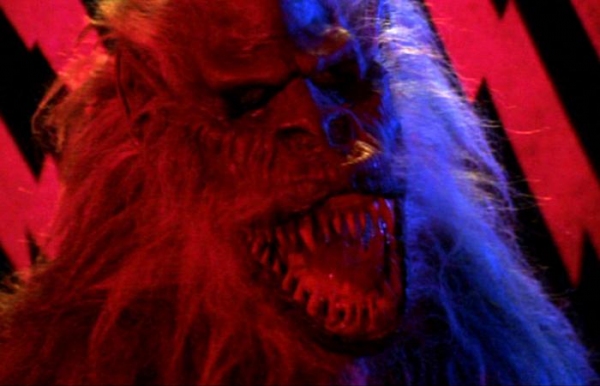
Third Night:
Creepshow
George Romero is known primarily for his Dead series, that increasingly self-conscious, ever more political, ongoing trash epic. From its trenchant, bargain basement beginnings to its outwardly satiric middle period, to last year’s thoroughly underappreciated, smartly timeless social commentary Land of the Dead, the Dead films have always displayed the odd congruence of humor and terror that Romero wields with the slickness of a grand ham. It’s almost like whimsy—especially effective when, in the Dead films, that blitheness is mixed with social awareness and cynicism produces empathy. There’s depth to Romero’s work; that’s why his seemingly negligible Stephen King anthology, Creepshow, seems rather anomalous. Creepshow was an homage to EC horror comic books of the 1950s, and a precursor to the HBO series Tales from the Crypt. Yet as obviously laden with nostalgia and gleeful gore as it may be, Romero’s film takes itself surprisingly seriously.
Hugely stylish, with its gross-outs and shockeroos rendered in crazy-comic histrionics, Creepshow looks and feels unlike Romero’s other, more naturalistic horror films. Split into five tales of varying success, penned by King at the height of his popularity, the entirety of Creepshow is nevertheless tonally cohesive. And with its gallery of grotesques, puppets and masks designed by Dawn of the Dead makeup master Tom Savini, the film feels as pleasurable as a tour through a Haloween haunted house…each boo is followed by generous bouts of laughter. “Father’s Day” is a classic back-from-the-dead, “Who Goes There?” treat, complete with an exquisitely designed worm-infested walking corpse; “The Crate,” the film’s lengthiest segment, is a nasty, delightful bit of misogynist wish fulfillment in which Hal Holbrook’s sad-sack university professor gets to feed his ball-breaker wife (Adrienne Barbeau, a nastier harridan than she even was in Back to School) to a ten-inch fanged wildebeast someone left in a box under the stairs; “They’re Creeping Up on You,” the most Romero-esque in its depiction of self-motivated isolation, concerns a particularly dreadful cockroach infestation in a high-rise apartment inhabited by a megalomaniac obsessed with social order and cleanliness.
The quick-witted, fleet comic book storytelling is a perfect match for Stephen King’s dime-store sense of vengeance and tidy resolutions, which in turn provide a neat little stage on which Romero can hone his comic gross-out skills. The tension created in the space between fear and parody was nothing new even at the time of its release (most of horror is set right in that in-between realm), but it’s not as easy to pull off as Romero, or often, Carpenter, make it look: Wes Craven’s been trying to accomplish the same tenuous balance for years. (A weekend watch of his 1991 The People Under the Stairs for me exemplified the gigantic gulf in his work between concept and execution; he’s woefully inept. Romero, on the other hand, knows when to mete out the scares, and when to keep the laughs quarantined.) Creepshow may remain as hopelessly one-dimensional as the pages from which it sprung, but I’ll take its paper-thin stylings over Sin City‘s comic approximation of “human experience” any day: in Romero’s film, there’s not an ounce of cynicism. —MK

Fourth Night:
The Innocents
The pedigree of The Innocents is so estimable that one would think the film to be bronzed upon delivery: Henry James adapted to the screen by Truman Capote (!) starring British Hollywood royalty Deborah Kerr, and directed by an up-and-comer named Jack Clayton, whose prior film, the kitchen-sinky Brit new waver Room at the Top, got a Best Picture nomination. What’s most surprising, even forty-five years later, is that The Innocents remains one of the least compromised, most genuinely unsettling studio films of the 1960s, a horror film in both the metaphysical and psychological senses, brought to the screen with more care and craftsmanship than the haunted-house genre probably ever received before or since. Robert Wise’s The Haunting, similarly black-and-white and predicated upon the thin line between possession and madness, stole its thunder two years later, and seemingly for the rest of the century: the latter, a slightly more resolved and narratively accessible trip into the supernatural, shows up regularly on Scariest Movies of All Time lists, while Jack Clayton’s devastating journey into the interior world of the haunted has been greatly forgotten.
What a shame, because anyone who pops in the recently released DVD of The Innocents is in for a big, wide shock: this Cinemascope adaptation of James’s The Turn of the Screw is one of the most exquisitely modulated ghost stories ever shot. When I say that The Innocents is the most “classical” of horror films, I refer primarily to its view on death. Death is here something to be profoundly feared, something that can’t be quantified; the ghostly realm exists not as a concept but as a reality and an end point. Vividly representing that fear is Deborah Kerr’s increasingly wide-eyed Miss Giddens, the pastor’s daughter who takes the job as governess of two young orphans at a remote British estate; her transition from tremulous truth-seeker to manic madwoman, as she begins to suspect that young Miles and Flora are possessed by the spirits of the dead, is so gradual as to be imperceptible, and her invocation of fear is breathtakingly palpable, even as we begin to distrust it. Yet young Pamela Franklin and, especially the preternatural man-child Martin Stephens (who one year before was in Village of the Damned, natch) are every bit her match; theirs is a secret world (the world of children, perhaps nothing more?) that Miss Giddens begins to greatly distrust, until she tries to violently snap them out of it.
What’s most remarkable about The Innocents isn’t merely its tonal and narrative faithfulness to Henry James’s story (it is simply shocking that the film has the same grim ending as the book), but that in so doing, Clayton still manages to make something uniquely, utterly cinematic. The Innocents features some of the most effective 2.35:1 compositions in film history, as well as the best use of the dissolve cut I can recall in a mainstream movie (often one scene will fade out onto one another, slowly, lingering as though draped over the next like a vapor, or a death shroud). There are more grab-your-throat gasps and literal hair-raising moments in this film than even in its soul sister, Alejandro Amenabar’s masterful 2001 homage The Others, which managed to create its own unique world while trading in Clayton’s same hushed, candlelit setting.
The Innocents is a ghost story (faces materialize at nighttime windows, a woman dressed in black appears amongst tall reeds by a rippling pond, shadows and silhouettes seem to dance at the corners of every wide frame), yet it’s not content to just be a ghost story. Even James’s sexual frankness, and intimations of pedophilia snake their way onto the screen—preadolescent Miles’s supposed possession by the “handsome” lothario Quint makes for some seriously perverse magnetism between he and his “pretty” governess. The Innocents hasn’t dated a day thanks to its sophisticated ambiguity; here, explanations mean nothing, and nobody has answers, just an endless tangle of secrets, hazy motivations, and impenetrable facades. As close as we get to Kerr’s unraveling governess, the less we know her, until it’s far too late. —MK
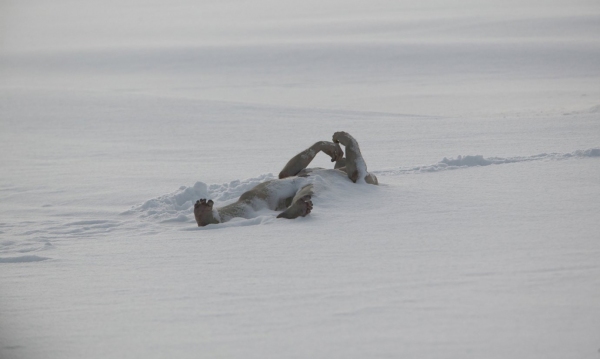
Fifth Night:
The Last Winter
As Kiyoshi Kurosawa’s latest, the self-derivative Retribution, has temporarily disappointed those who believe a genuine horror auteur can exist—a filmmaker who can expertly work within genre conventions even as he pushes far beyond the safety of the genre’s borders—one can take heart from the fact that Kurosawa’s example has spread to an American disciple. The masterful touches scattered throughout Larry Fessenden’s first two efforts, Habit (1997) and Wendigo (2001), portended a masterpiece to come. Five years hence, Fessenden’s career-suicidally ambitious The Last Winter, while far too flawed to ever qualify as a masterpiece, triumphs through its own ultimate “failure.” Put another way, it has to fail as a horror film in order to achieve its aim: to burst through the generic borders and images that hem its horrors in and strike us at our most naked, vulnerable, fearful point.
Unlike the comfortable “archetypes” (read: clichés) with which so many “ambitious” would-be horror directors skim across any real investment in their material—see, or rather don’t see, Lucky McKee’s upcoming The Woods—Fessenden has an actual subject—a subject so pressing, horrifying, and unthinkable that the great majority of us, of necessity, push it to the back of our minds. As with Kurosawa in Charisma, Fessenden does not use the horror form to allegorize, or exploit, the ecological apocalypse he forecasts in The Last Winter. He uses it to break that dread open, to give its terrifying formlessness a transitory form. And as he gathers portents of a horrible revelation to come, he deliberately pushes the abilities of cinematic representation to incarnate that unimaginable fear.
So The Last Winter thus creates and maintains two levels of suspense throughout its length. The first is Fessenden’s, in his often brilliant command of the horror tropes he employs: over and over again, he creatively undermines our expectations by stifling or cutting short the expectedly “scary” bits and introducing jagged rhythms and unsettling discrepancies into what should be the rest periods between scares. The second is ours, as we wonder, hope, that the revelation can possibly equal the masterful build-up Fessenden has given it.
To put it simply, it doesn’t. But the gonzo insanity of the last ten minutes, so drastically breaking with the slow, gathering dread that preceded it, almost seems a humble confession on Fessenden’s part: a confession that nothing he puts on the screen could possibly be more frightening than the reality he’s concerned with. The Last Winter ultimately isn’t “satisfying” because there is no real-world satisfaction for what it speaks of. This horror cannot be contained in our stories or our images. It has a logic of its own so alien to ours that even our best attempts to decipher it must fail, and our knowledge be limited to an awareness of its implacable approach. Hoots and jeers might accompany the finale of The Last Winter, but they’re only a coping mechanism for the terrible truth it uncovers: what it knows about that which is impossible to know. —Andrew Tracy
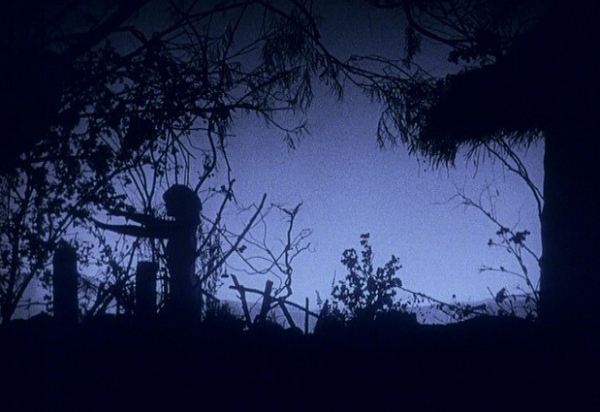
Sixth Night:
Häxan
I’d need to consult an early-cinema historian, but Benjamin Christensen’s silent curiosity Häxan (1922) (a 1966 re-release featured a wretched free-jazz score and dead-serious, director-derided voice-over narration by William Burroughs; both cuts have been sturdily enshrined on DVD by Criterion) is almost certainly the first feature-length movie to feature boiled babies. The little dumplings are being prepared in honor of a midnight meeting between Satan and a coven of broomstick-riding witches. Said confab is just one of several spectacularly realized, vintage-woodcut style friezes dotting Christensen’s well-and-truly certifiable pseudo-documentary, one of the most visionary—and lethally pointed—horror-comedies ever made.
Not only does the film, a portentous-on-purpose tour of occult lore featuring overwrought, beautifully detailed “dramatizations” of “witchcraft through the ages,” have it both ways, but it does so with such nimble-fingered skill (it fairly teems with Expressionist-ish brio) that those ways have no choice but to take it and like it. Its contents – artifacts, paintings, breathless descriptions of the black arts, nude nymphos, moonlight Bacchanals, corrupted priests, Christensen himself as a fork-tongued, dirty-minded Devil whose ass is literally kissed by his disciples—are gloriously lurid, but the director is callow like a fox.
As the straight-faced tone crinkles into a barely suppressed grin, it’s evident that this peep-show inventory has a very real subject: the hypocrisy of fear-mongering religious institutions that loudly decry the very hysteria they’ve helped to massage in their constituency. Häxan goes into exacting detail about Inquisition-era torture devices, explicating their effects on the human anatomy in clinical detail. It’s a prurience born of empathy – the unmissable point is that the countless “witches” murdered and mutilated in the name of religious purity were victims of force-fed misogynist panic and pulpit-sent communal naiveté. (As if these Church-baiting postulations needed reinforcing, the film presents the clergy as either smiling sadists or weak-kneed slaves to temptation.)
Christensen organizes the final segment of the film around the thesis that the poor wretches previously taken for witches were in fact sufferers of garden-variety “female hysteria.” Whether or not Christensen’s heart is in this specious sociology (surely the superimposition of a classic broomstick-riding witch onto a photograph of a female aviator is done with tongue so firmly in cheek as to produce choking), the underlying suggestion that we’ve merely refined our intolerance (much is made of present day’s society’s compassion in incarcerating, rather than incinerating, its outcasts) has some sting to it. —Adam Nayman

Seventh Night:
Poltergeist
Even if you don’t know me personally, it may not come as much of a surprise that I’m fairly familiar with Poltergeist: take a look at my username. Hailing from the same era as so many cultural phenomena which defined a generation, Poltergeist stands apart from the Star Wars, Alien, and Indiana Jones pictures for its singular generic makeup: it’s a haunted house picture as special-effects roller coaster ride. It’s the creaky ghost-house redefined for Spielbergian family values, reconfigured in prefab suburbia, and rigged up in state-of-the-art blue-screen and prosthetics. it’s thoroughly aware of its own placement in the blockbuster cosmos—Robbie Freeling, middle-child, terrorized by malevolent kid-eating trees and diaboliocally grinning clown dolls, packs his bedroom with memorabilia: Darth Vader, sci-fi posters, a jacket emblazoned with that latter-day Wolf Man, Chewbacca.
It’s not surprising then, that Poltergeist, for many kids now in their twenties, was their first horror movie. Famously rated PG (which in part, along with other Spielberg products made to terrorize tots, including Gremlins, helped establish the PG-13), the movie is something like a particlarly gruesome Little Golden Book; it could be subtitled “My First Horror Movie.” Not that the film isn’t at times truly horrifying: it can still send shivers up the spine (those skeletons popping up from underground in the family pool; that persistent stuffed circus freak) and cause stomach discomfort (a man—with the aid of an off-screen Spielberg’s own two hands—rips his own face off in pulpy chunks in front of a bathroom mirror); but what makes Poltergeist so oddly accessible for the young mind is the film’s forthright placement in the everyday goings on of an average family. Despite its foreboding opening (with little Carol Anne perched in front of the TV late at night, talking to its black and white fuzz after it’s signed off for the night), Spielberg’s script takes a lot of time to establish the humorous, very normal, interactions of its various family members: former hippie dad turned real-estate agent Steven, trying to find his conservative side (he’s seen reading a Reagan biography, in full camera view); live-at-home mom Diane juggling three kids, housework, and her once active ‘70s open mind (she smokes pot when the kids are in bed and hides the stash when the kids come complaining they can’t sleep); eternally pissed teenager Dana; timid, yet brashly masculine 8 year-old Robbie; and of course, angelic, impressionable 5-year-old Carol Anne, who will be swept away into the otherworld, through the spiritual conduit of the TV.
A joint production between Spielberg and director Tobe Hooper—a renowned “collaboration” which resulted in much, much, much confusion on set and in the press over who had creative control over the film—Poltergeist is always considered, easily, an odd mix of Spielbergian sentimentality and Hooper-esque gore and grime. If only it were that simple: Spielberg’s always shown a penchant for scaring the living shit out of people (particuarly tots). What is Hooper’s and what is Spielberg’s has always seemed reductive—what matters is that the joint effort forced both filmmakers to do something just a little different…it’s Spielberg’s first ever full-throttle scare machine, and it’s Hooper’s most character-driven, satisying emotional narrative.
Poltergeist‘s concerns with the spirit world (it devolves into a lot of tantalizing mumbo jumbo about the “light” and crossing over) often seem to take a back seat to its primary power as a supreme sound and light show (it’s the one film where Spielberg’s need to flood everything with backlighting actually has a narrative context). No doubt, Poltergeist is touching, and its literal rebirth narrative—in which a mother must reclaim her daughter and push themselves back through a goopy plasmic birth canal into our world, i.e. the living room—gives the haunted house genre some metaphorical heft; but it’s most memorable as a gallery of beasties and eye-popping wonders.
More than anything, it’s the sheer awe with which the film views the spirit world that makes it not just scary, but transcendent. When the ghosts first invade, and their intentions seem rather harmless (they simply move some furniture around and break some glasses), Diane embraces the intrusion with childish delight, jumping up and down and clapping her hands. She even sets up floor diagrams in the kitchen to demonstrate the otherworldly power for her baffled husband. Such glee is shortlived. (It’s all fun and games, till somebody loses a child…) It’s the most refreshing twist on the haunted house genre I can recall—and a brilliant evocation of misguided 70s hope and freedom transitioning to 80s disillusionment. —MK
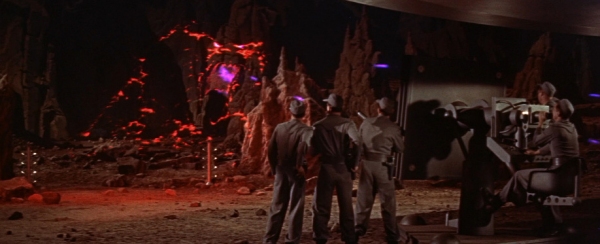
Eighth Night:
Forbidden Planet
Fred M. Wilcox’s 1956 sci-fi classic Forbidden Planet may seem an odd addition to our Halloween spectacular, especially given that it’s more famous for its most memorable character, the bibendous, fey, talking robot Robbie, than actual scares. But I’ll proudly stand up and say that my regular childhood viewings, even those on sunny weekend afternoons, were marked with liberal doses of sheer terror. Whether it’d still work for me as truly scary now is perhaps questionable, but the terrific conceit of a gigantic, invisible monster stalking the unawares at night (I won’t ruin the surprise of its origins, one of my favorite all-time ideas of the genre) still compels me to think on it from time to time. Wilcox does a terrific job of teasing out our knowledge of the creature: starting with depressions in the ground caused by invisible, clawed feet, graduating to metal structures damaged by an obviously large beast, and then its initial terrible illumination by laser/taser fire in a massive firefight. In and amongst more placid sequences, these evening attacks play as any good business featuring a stalking murderous interloper should. By the film’s climax, as the whole forbidden planet is literally falling apart at the seams, and the creature stages a final attack, its true nature has been revealed and the film’s vaulted into the realm of one of the headier sci-fi confections of the day.
From the instant Commander John J. Adams (Leslie Nielsen) and his crew land on the distant planet Altair-4 to investigate a lost colony, things are, most decidedly, “off.” And given the planet’s remaining population of three—Dr. Edward Morbius (Walter Pidgeon), his daughter Altaira (Anne Francis), and their servant Robbie—when corpses start piling up, questions mount even more quickly. Cyril Hume’s screenplay, loosely based on Shakespeare’s The Tempest (when was the last time we’ve been able to say that about a new science fiction film?), is populated with a sense of creeping dread that questionable delivery from leads Nielsen, Francis, and Pidgeon can’t quite squash (it may well be that some of what’s so great about 50s sci-fi lies in how performance independent it can often be)—Planet ably pulls off the sci-fi/horror hybrid that’s flummoxed more than a few filmmakers.
You wouldn’t expect this kind of slow-burn from a director who’d put out three Lassie movies in the years prior, but assisted by massive amounts of Theremin, spot-on production design which overflows with a feeling of fragile isolation, ingenious sound work and what were once state-of-the-art FX that remain surprisingly impressionistic, the whole thing adds up to well more than the sum of the average MST3K knock-off. It’s the perfect Halloween film for those who prefer science fiction to more traditional scary flicks. —Jeff Reichert
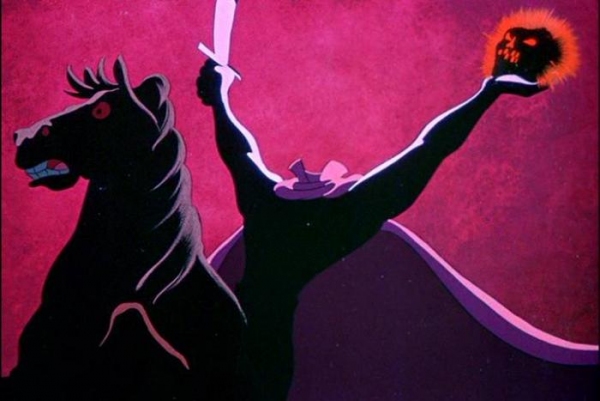
Ninth Night:
The Legend of Sleepy Hollow
Tim Burton’s 1999 Sleepy Hollow was truly one of the most disheartening missed opportunities in all of film—a ground-up genre pulp riff on Hammer films by way of Washington Irving that not only bore no resemblance to its alleged source material but also had no personality, soul, or narrative heft. Burton’s “adaptation” is more like a badly related story from a dorky kid who claims to have read the book but can only rely on third-hand information: “Yeah, it’s about a headless horseman…and he kills people…and stuff.” Hence, it’s a monotonous series of elaborately (read: dully) staged beheadings, with endless lines of Burton’s child-scrawled scarecrow grotesques dotting the landscape. At least we still have the real deal: Disney’s The Legend of Sleepy Hollow, thirty-five minutes of clever, tuneful, and surprisingly gripping animated joy, originally packaged alongside The Wind in the Willows (also excellent) for the 1949 release The Adventures of Ichabod and Mr. Toad. Even as it’s greatly geared towards the kiddies, Legend of Sleepy Hollow manages to be more, satiric, exhilarating, and evocative of its story’s time and place than Burton’s backbreakingly art-directed fluff, which seems to have spared no expense.
While it may not be the Greatest Pumpkin of them all, Disney’s Sleepy Hollow trails a close second to Linus’s faithful night in the pumpkin patch in the animated Halloween Olympics. Narrated by a gamely crooning Bing Crosby, this is Disney at the top of its craft, though it was made when the studio was in somewhat of a postwar downslide war, one of a series of shorts within omnibus films that they were almost exclusively making at the time. Alongside other subjects such as Pecos Bill and Johnny Appleseed, Disney was insistently propagating Americana throughout the decade, for better and for worse, but Sleepy Hollow remains the best of them, a perfectly balanced, elegantly detailed example of Disney’s penchant to condense literature into an accessible package, without sacrificing nuance or detail. A lot of care and cleverness went into adapting Washington Irving’s highly allegorical tale: Irving’s gently sarcastic omniscience becomes Crosby’s sassy, tuneful narration (complete with a host of toe-tapping numbers filled with ironic remove); sketchy schoolmaster Ichabod Crane’s voracious opportunism is reimagined in slapstick terms, as a rapacious appetite for women, food, and land. In this passage from Irving’s book we may see the makings of Disney’s literalized metaphors: “He was, in fact, an odd mixture of small shrewdness and simple credulity. His appetite for the marvelous, and his powers of digesting it, were equally extraordinary; and both had been increased by his residence in this spell-bound region.” Though thin as a rail, he’s often seen wolfing down entire roasted chickens and swallowing pies in one nasty gulp.
Most impressively, the film maintains the ambiguity of its story’s central Dutch-settled, New American mythmaking. The Headless Horseman, a spirit summoned up by fireside storytellers to scare children—as well as itinerant teachers vulnerable to local superstitions—represents new-old-world cold comfort at its least forgiving. Is the horseman, according to Irving’s legend beheaded by a cannonball during the Revolutionary War, more fearsome because it might be a vengeful human in disguise or because it might not be? The bullyish local Brom Bones drives out Ichabod not just because he’s stealing the eye of the thoroughly flirtatious, highly manipulative Katrina Van Tassel, but also because Ichabod represents an unwanted intrusion to the enclosed community. Not just faithful, the film is also exquisitely designed to terrify: even before Ichabod’s final fateful Halloween ride through the midnight woods, there is an exquisite use of multiplane animation in which the branches and trees of the nighttime forest literally close in on Ichabod, with overlaying animated cells. It’s a beautifully cartoonish evocation of fear, and exactly what children’s filmmaking should do: boil things down to their primal core, with simple visual metaphors.
Then, the slow, suspenseful build-up (far off hooves clomping ever closer; the moon cupped by the hands of grey clouds; frogs croaking out Ichabod’s name in foreboding) to the deliriously exciting finish—Ichabod’s desperate face, the Horseman’s headless indifference, the race to the hallowed ground of the bridge and church. It’s simply thrilling, with more of an understanding of basic narrative mechanics that Burton could ever grasp. Then, the shattered pumpkin. —MK
